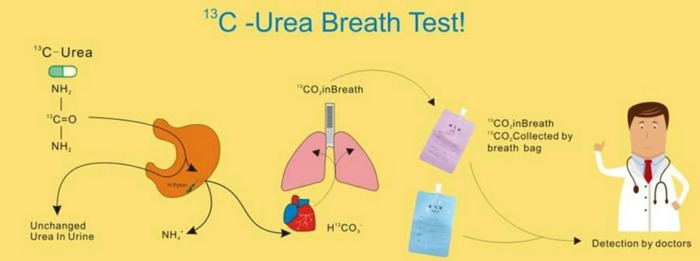Urease Test
Last reviewed by Editorial Team on February 27th, 2019.
A urease test is a procedure that helps identifies microorganisms that have the ability to hydrolyze urea to produce ammonia and carbon dioxide.
A urea is a compound that produces nitrogen during amino acid arginine decarboxylation in the urea cycle. A urea is a waste product of protein digestion and is excreted from the body through urination.
To be able to break down urea, some bacteria produce an enzyme urease; a hydrolytic enzyme that attacks carbon and nitrogen bond. Hence, a urease test is performed to identify certain types of bacteria.

Image 1: A urease test with two test tubes; the one on the left is negative while the one on the right tests positive.
Picture Source: microbiologyinfo.com

Picture 2: A urease test to check for the presence of Helicobacter pylori.
Photo Source: www.researchgate.net
What is the purpose of the urease test?
- The primary purpose of the test is to differentiate urease-positive Proteeae from other Enterobacteriaceae.
- It differentiates microorganisms based on their ability to hydrolyze urea with urease enzyme.
- It is helpful in identifying Cryptococcus spp, H. pylori, Brucella, and other types of bacteria that produce urease enzyme.
- It is performed on gastric biopsy samples so as to determine the presence of H. pylori. (1, 2, 3, 4)
What is the medium used?
Any urea medium can be used. It can be an agar or broth. The broth is usually used as a differential medium, which tests the ability of the microorganism to produce urease.
It contains two pH buffers: urea and a pH indicator phenol red. The latter turns yellow when exposed in an acidic environment. Its color changes to fuchsia when exposed in an alkaline environment.
The medium turns pink if the urea is degraded and ammonia is produced. (3, 4, 5)
What is the principle of the urease test?
The urea is diamide of carbonic acid, which is hydrolyzed with the production of ammonia and carbon dioxide.
A lot of microorganisms contain urease enzyme and they have the ability to split urea in the presence of water so as to release both the carbon dioxide and ammonia.
A perfect example is a microorganism that infects the urinary tract. (4, 5)
How is the urease test done?
- Inoculate the broth medium with a loopful of a pure microorganism.
- Incubate the test tube at 35 degrees Celsius in ambient air for at least 24 hours. Some microorganisms require a longer incubation time. Make sure you leave the cap on loosely.
- If the microorganisms being tested can hydrolyze urea rapidly, you will be able to see some changes within 1 to 2 hours. For microorganisms that are less active, you may see the results after a few days.
- A routine urease test result is interpreted within 24 hours.
- A microorganism that produces urease changes the color of the slant from light orange to magenta or fuchsia.
- A microorganism that does not produce urease will not produce any significant changes in the color of the medium. (5, 6, 7, 8)
Types of urease test

Photo 3: A rapid urease test which is also known as the campylobacter-like organism test.
Image Source: www.researchgate.net

Image 4: A urea breath test.
Picture Source: img.diytrade.com
- Rapid urease test/ Campylobacter-like organism test – It differentiates microorganisms like Cryptococcus neoformans and Candida albicans.
- Urea breath test – A non-invasive procedure that detects the presence of H. pylori based on the urease activity. This procedure is done by ingesting a radioactively labeled urea. A Helicobacter pylori produces urease in an infected person. The microorganism hydrolyzes the urea forming bicarbonate which is then exhaled in the form of carbon dioxide. The carbon dioxide is measured using a special spectrometer. (3, 6, 8, 9)
What are examples of urease positive organisms?
- Corynebacterium spp
- Proteus spp
- Helicobacter pylori
- Cryptococcus spp
- Brucella spp
- Yersinia spp
- Nocardia
- Morganella spp
- Providentia spp
- Staphylococcus saprophyticus
- Mycoplasma (3, 10)
What are examples of urease negative organisms?
- Escherichia
- Shigella
- Salmonella (2, 4)
Example of a weak positive urease organism
- Klebsiella pneumoniae
Are there any limitations?
- Interpreting the test can be quite of a challenge because some microorganisms can split urea rapidly while others react slowly.
- To completely identify urease positive organisms, a biochemical or serological test should be performed.
- Avoid using inoculum from a broth suspension so as to facilitate the growth and hydrolysis of urea.
- Make sure you do not heat the urea agar slant as the heat decomposes the urea.
- If you are testing for a Proteus species, you should examine the urea agar slant for reaction within six hours of inoculation.
- It is important to incubate the urea agar medium with a loose cap as failure to do so could lead to an erroneous result.
- Store the urea agar medium in a dark place as it is extremely sensitive to light. Exposing the medium to light makes it prone to auto hydrolysis. (3, 8, 10)
References:
- https://en.wikipedia.org/wiki/Rapid_urease_test
- http://www.austincc.edu/microbugz/urease_test.php
- http://www.asmscience.org/content/education/protocol/protocol.3223
- https://microbeonline.com/urease-test-principle-procedure-interpretation-and-urease-positive-organsims/
- https://microbiologyinfo.com/urease-test-principle-media-procedure-and-result/
- http://vlab.amrita.edu/?sub=3&brch=76&sim=214&cnt=1
- http://vlab.amrita.edu/?sub=3&brch=76&sim=214&cnt=2
- https://www.sciencedirect.com/topics/pharmacology-toxicology-and-pharmaceutical-science/rapid-urease-test
- http://www.biologypractical.com/urease-test-objective-principle-procedure-and-result/
- https://www.biosciencetimes.com/study-notes/microbiology-study-notes/urease-test-principle-procedure-and-result/197/
